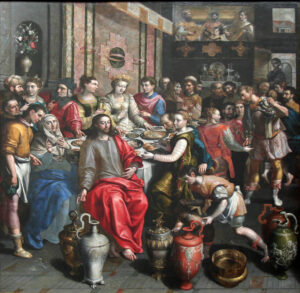Christ’s death completes the incarnation
Re: “Atonement,” Nov. 11, 2013, page 4.
The main issues around the atonement appear to centre around two questions: “Why did Jesus have to die?” and, “What does this say about God?” On the first one, after quoting a number of Mennonite theologians, probably wisely, the article admits that mystery remains. On the second, it agonizes over whether God commits violence and whether “God requires a death for justice to be done.”
Let me touch on the questions about God first.
The idea that God had to act in a certain way to satisfy some “law” or concept of justice is problematic. Some of the understandings of atonement have a legal, or even legalistic, core or base. Isn’t God, by definition, answerable only to God?
Someone has said that to understand God we need to see God as “pure will”: “I will be what I will be” (Exodus 3:14) The parable of the labourers in the vineyard in Matthew 20 illustrates that God is not bound by human “laws” of fairness.
Among the atonement metaphors mentioned in the article, I believe the “reconciliation motif or metaphor” gets closer to an Anabaptist understanding. Reconciliation, of course, is far more than a metaphor. In one word it describes the aim and the result at the heart of what is meant by atonement: “In Christ God was reconciling the world to himself, not counting their trespasses against them” (II Corinthians 5:19). “Not counting” is a free act of the will. Would God’s honour be besmirched if he forgave freely?
Why then did Jesus “have to die?” To round out, or complete, the incarnation.
Recall Jesus’ word to his disciples about “taking up the cross.” Living for others was the heart of that, and so dying for others kind of follows. It was a kind of logical fulfillment of the Word becoming flesh.
The atonement was accomplished in Jesus’ prayer: “Father forgive them, they don’t know what they are doing.” Had that not been in his heart, I dare say, the blood shed that day would have had less meaning. Does not that prayer, along with the Gethsemane prayer, sum up atonement?
Jesus did not call on “legions of angels” to save him from those out to kill him. The power of the cross of Jesus lies in that he did not resort to evil means in dealing with his opponents. In a sense, he had to die to show that love is stronger than hate and evil. That is necessary for our salvation from evil and death. The resurrection was God’s corroboration, or stamp of approval, of that.
Jesus taught that we should love our enemies. Does God do less? Atonement is an act stemming from the heart of God, an act of pure will freely done. Jesus’ death does not unleash God’s love; it demonstrates it.
Bill Block, Winnipeg
Confession of Faith needed to guide MC Canada’s future
We sincerely encourage our fellow readers to submit messages or articles to Canadian Mennonite using the Confession of Faith in a Mennonite Perspective as their guide. Specifically, messages on Article 17: “Discipleship and the Christian life,” and Article 19: “Family, singleness and marriage,” would be welcomed. We believe that this is urgently needed at this time, as we are determining the future direction of our church.
Ken and Geryl Schaaf, North Battleford, Sask.
‘A truly prophetic voice’ will be missed
Re: “A lament for the loss of a New Order Voice,” Jan. 20, page 10. I want to thank Carl DeGurse for his letter lamenting the loss of Aiden Enns’s column.
For many of us, Enns and the community of Hope Mennonite Church, Winnipeg, represent a beautiful new vision of church that is radically inclusive and on the cutting edge of environmental stewardship. A truly prophetic voice is hard to listen to. We want to turn it off, shut it out.
Stuart Murray of the Anabaptist Network in the United Kingdom told us in Winkler, Man., last year that most denominations there had rid themselves of their visionaries, a sure recipe for stagnation and death.
I want to thank Enns and Canadian Mennonite for eight years of thought-provoking New Order Voice columns.
Della Lee, Brandon, Man.
Thanks for exposing ‘the best kept secret’
Re: “Unlearning the Bible to welcome homosexuals,” Jan. 6, page 15.
The Viewpoint column by Gerhard Neufeld provides us with very interesting information. I realize that these ideas have been taught quietly for many years in the various Mennonite schools in North America, but this is one of the first times that we have actually seen them in print. Good! Keep them coming.
We may not agree, but at least now the constituency can know what is taught behind the closed doors of our schools. So God created a second option along with heterosexuality? Very interesting. This has been the best kept secret this world has ever known.
Do you have any more secrets for us? Bring them on.
David Shantz, Montreal
MennoMedia questioned over John Howard Yoder disclaimer
Re: “Disclaimer to be included in John Howard Yoder books,” Jan. 6, page 28.
When have leaders of the Mennonite churches ever conducted a “trial” in which the defendant is 17 years dead and the plaintiffs are unknown to most members of the Mennonite churches?
Since when has an exercise in church discipline involved so much silence? Who are the plaintiffs?
Were the plaintiffs at the time of the offence responsible moral agents? Did they, as adult graduate students, have the freedom to say no when abused, or are we to regard them as defenceless victims? Or were they so naïve that they did not recognize abuse when they themselves were the objects?
Are we free, as God’s people, to put this disclaimer as a millstone around Yoder’s neck forever, without a new process involving him? What are we to make of Psalm 103:9: “He will not always chide, nor will he keep his anger for ever”?
Are we, as God’s people, free to inflict pain and suffering on the Yoder family in the interests of justice for others, when the family members themselves are not at fault in any way?
In the light of MennoMedia’s decision, what are we to make of Jesus’ action with the woman caught in adultery in John 8? Did Jesus and others suggest later that the process had been flawed and therefore had to be taken up again?
Will this disclaimer restore justice? Will it make people more thoughtful, more merciful, more generous towards offenders?
Are the Mennonite churches really prepared to reject the legal protection of double jeopardy, since Yoder was already legitimately convicted by congregational process?
Walter and Ruth Klaassen, Saskatoon
Harry Loewen, Kelowna, B.C.
Vern Ratzlaff, Saskatoon
Who belongs at communion?
Re: “Bread, acceptance and covenant” feature by John D. Rempel, Jan. 20, page 4.
While I deeply respect Rempel’s engagement with understanding the Lord’s Supper, and was pleased with the wider context of Jesus’ other meals in which he places this treatment of it, I had a hard time getting beyond this paragraph: “ ‘Openness to outsiders’ is a better description of what Jesus demonstrates in the gospels. His invitation is an act of hospitality to guests. Yet hospitality is not the same thing as belonging . . . .”
His statement crystallized the continuing discomfort I have about the various ways we acknowledge the presence, and invite the participation of, the unbaptized during Sunday morning communion services.
In my advocacy for the appropriate inclusion of those members of the family of God who are not ready for believer’s baptism in communion, I have often encountered arguments that stress the inclusion of everyone in the celebration of Jesus’ other meals, his meals of hospitality.
But if hospitality is not the same thing as belonging, and I agree that it is not, how do we communicate that those who are still on the road toward their believer’s baptism—especially those who are not cognitively mature enough to qualify for adult baptism—definitely belong and are a precious part of the family of God?
In our current context, where multiple virtual communities shape the identity and vie for the allegiance of the young, the church needs to be especially clear in communicating that the young belong and have a special place in the family of God.
Noule Moules of the Anabaptist Network gathers worshippers around a table in the U.K. that integrates the “love feast” with the Lord’s Supper. Children are at the centre of that worship.
I suggest a dual invitation to the table in my “Inclusive initiation to the communion table” document that can be downloaded at http://bit.ly/1bNEYeG. I thank Canadian Mennonite for featuring this important topic, and look forward to a wider conversation on it at this summer’s assembly, where a seminar will address the topic from the perspective of what we really believe about children.
Elsie Rempel (online comment)
How does one eat like a Mennonite?
I and my spouse, plus another family, had supper together last evening and we brought in fish and chips! So I’m wondering, were we eating like Mennonites?
When I was a student at Canadian Mennonite Bible College, I enjoyed many of Annie Janzen’s zwieback during our Sunday dinners. However, zwieback symbolizes the place of food in only one of many cultural backgrounds which are to be found in the Mennonite church worldwide, and, for that matter, cultures represented in this same issue of Canadian Mennonite (“Eating like a Mennonite,” Feb. 3, page 30).
David Ringer, Toronto







Leave a Reply
You must be logged in to post a comment.